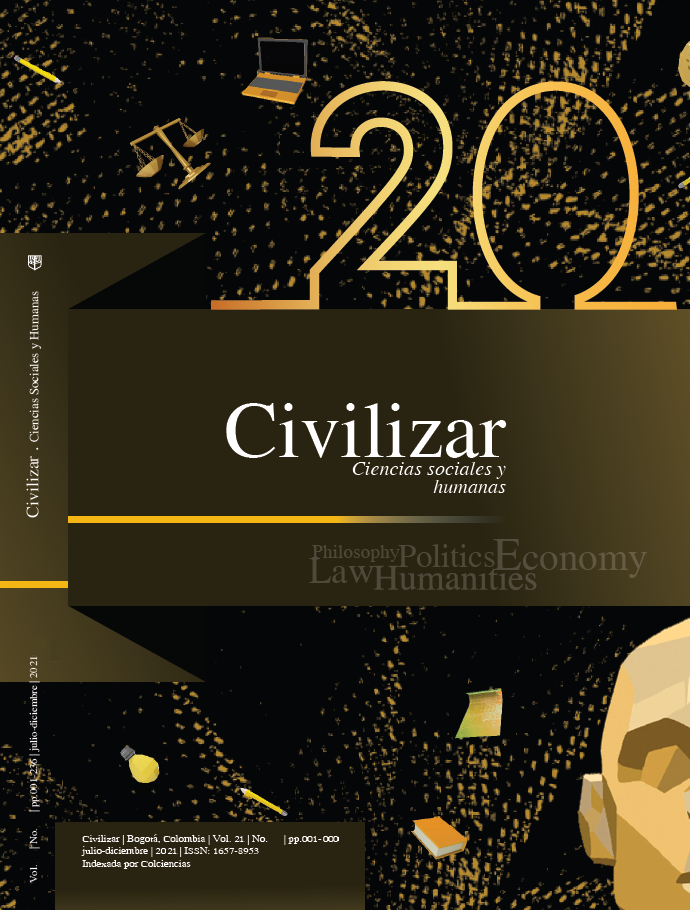Abstract
The purpose of this paper is to conduct a theoretical analysis of the main heterogeneous agent models in the context of the current global covid-19 pandemic. The typical representative agent models used in macroeconomic policy analysis are no longer relevant, as empirical evidence has identified a large number of heterogeneous agents that respond more closely to reality. The analysis starts from Friedman's pioneering approaches to the consumption function, includes elements such as the liquidity constraints faced by individuals, refers to the HANK and TANK models applied to different contexts, and, finally, a theoretical approach to the analysis of the current pandemic situation in the framework of the models studied.
References
Auerbach, A. J., Gorodnichenko, Y. y Murphy, D. (2020). Fiscal policy and covid19 restrictions in a de¬mand-determined economy. NBER Working Paper no. 27366. https://doi.org/10.3386/w27366
Baker, S. R. (2014). Debt and the consumption response to household income shocks. SSRN Research Paper no. 2541142. https://doi.org/10.2139/ssrn.2541142
Bayer, C., Born, B., Luetticke, R. y Müller, G. J. (2020). The coronavirus stimulus package: How large is the transfer multiplier? CEPR Discussion Papers no. 14600. https://cepr.org/content/discussion-papers
Blanchard, O., Amighini, A. y Giavazzi, F. (2012). Macro¬economía. Pearson Educación.
Broda, C. y Parker, J. A. (2014). The economic stimulus payments of 2008 and the aggregate demand for consumption. Journal of Monetary Econom¬ics, 68, S20-S36. https://doi.org/10.1016/j.jmone¬co.2014.09.002
Broer, T., Harbo, N. J., Krusell, P. y Öberg, E. (2020). The New Keynesian transmission mechanism: A heterogeneous-agent perspective. The Review of Economic Studies, 87(1), 77-101. https://doi.org/10.1093/restud/rdy060
Campbell, J. Y. y Mankiw, N. G. (1989). Consumption, in¬come, and interest rates: Reinterpreting the time series evidence. NBER Macroeconomics Annual, 4, 185-216. https://doi.org/10.1086/654107
Campbell, J. Y. y Mankiw, N. G. (1990). Permanent in¬come, current income, and consumption. Journal of Business & Economic Statistics, 8(3), 265-279. https://doi.org/10.1080/07350015.1990.10509798
Campbell, J. Y. y Mankiw, N. G. (1991). The response of con¬sumption to income: a cross-country investigation. European Economic Review, 35(4), 723-756. https://doi.org/10.1016/0014-2921(91)90033-F
Cepal (2021). El impacto social de la pandemia en Amé¬rica Latina. Claves de la Cepal para el desarrollon, n.º 8: Panorama Social de América Latina 2020. https://repositorio.cepal.org/handle/11362/46740
Chetty, R., Friedman, J. N., Hendren, N. y Stepner, M. (2020). How did covid-19 and stabilization policies affect spending and employment? A new real-time economic tracker based on private sector data. NBER Working Paper no. 27431. https://www.nber.org/papers/w27431
Cloyne, J. S. y Surico, P. (2017). Household debt and the dynamic effects of income tax changes. The Re¬view of Economic Studies, 84(1), 45-81. https://doi.org/10.1093/restud/rdw021
Cox, N., Ganong, P., Noel, P., Vavra, J. S., Wong, A., Far¬rell, D. y Greig, F. (2020). Initial impacts of the pandemic on consumer behavior: Evidence from linked income, spending, and savings data. Brook¬ings Papers on Economic Activity, 2020(2), 35-82. https://doi.org/10.1353/eca.2020.0006
Debortoli, D. y Galí, J. (2017). Monetary policy with het¬erogeneous agents: Insights from TANK models. Economics Working Papers no. 1686.
Elgin, C., Basbug, G. y Yalaman, A. (2020). Economic policy responses to a pandemic: Developing the covid-19 economic stimulus index. Covid Economics, 1(3), 40-53.
Friedman, M. (1957). A theory of the consumption function. Princeton University Press. https://doi.org/10.1515/9780691188485
Galiani, S., Heymann, D. y Tommasi, M. (2003). Great expectations and hard times: The Argentine Convertibility Plan. Economía, 3(2), 109-160. https://doi.org/10.1353/eco.2003.0005
Heymann, D. y Kawamura, E. (2009). Sobre el rol de las políticas fiscales y financieras en las fluctuaciones macroeconómicas. Económica, 55, 45-97.
Jappelli, T. y Pistaferri, L. (2010). The consumption response to income changes. Annual Review of Economics, 2, 479-506. https://doi.org/10.1146/an-nurev.economics.050708.142933
Johnson, D. S., Parker, J. A. y Souleles, N. S. (2006). Household expenditure and the income tax re¬bates of 2001. American Economic Review, 96(5), 1589-1610. https://doi.org/10.1257/aer.96.5.1589
Kaplan, G. y Violante, G. L. (2014). A model of the con¬sumption response to fiscal stimulus payments. Econometrica, 82(4), 1199-1239. https://doi.org/10.3982/ECTA10528
Kaplan, G., Moll, B. y Violante, G. L. (2018). Monetary policy according to HANK. American Economic Review, 108(3), 697-743. https://doi.org/10.1257/aer.20160042
Kaplan, G., Moll, B. y Violante, G. L. (2020). The great lockdown and the big stimulus: Tracing the pan¬demic possibility frontier for the U.S. NBER Working Paper no. 27794. https://doi.org/10.3386/w27794
Kaplan, G., Violante, G. L. y Weidner, J. (2014). The wealthy hand-to-mouth. NBER Working Paper no. 20073. https://doi.org/10.3386/w20073
Leijonhufvud, A. (1972). Effective Demand Failures. UCLA Economics Working Papers 027, UCLA De¬partment of Economics. https://ideas.repec.org/p/cla/uclawp/027.html
Misra, K. y Surico, P. (2013). Consumption, income changes and heterogeneity: Evidence from two fiscal stimulus programmes. American Economic Journal: Macroeconomics, 6(4), 84-106. https://doi.org/10.1257/mac.6.4.84
Parker, J. A. (1999). The reaction of household consump¬tion to predictable changes in social security tax¬es. American Economic Review, 89(4), 959-973. https://doi.org/10.1257/aer.89.4.959
Parker, J. A., Souleles, N. S., Johnson, D. S. y McClelland, R. (2013). Consumer spending and the economic stimulus payments of 2008. American Economic Review, 103(6), 2530-53. https://doi.org/10.1257/aer.103.6.2530
Pontes, G. (2021). Distributives and output effects of in¬come transfer after the covid-19 pandemic shock [tesis de maestría]. Insper, São Paulo. https://repo-sitorio.insper.edu.br/handle/11224/2842
Shapiro, M. D. y Slemrod, J. B. (2003a). Consumer response to tax rebates. American Economic Review, 93(1), 381- 396. https://doi.org/10.1257/000282803321455368
Shapiro, M. D. y Slemrod, J. B. (2003b). Did the 2001 tax rebate stimulate spending? Evidence from taxpay¬er surveys. Tax Policy and the Economy, 17, 83-109. https://doi.org/10.1086/tpe.17.20140505
Shapiro, M. D. y Slemrod, J. B. (2009). Did the 2008 tax rebates stimulate spending? American Econom¬ic Review, 99(2), 374-79. https://doi.org/10.1257/aer.99.2.374
Souleles, N. S. (1999). The response of household con¬sumption to income tax refunds. American Economic Review, 89(4), 947-958. https://doi.org/10.1257/aer.89.4.947
Werning, I. (2015). Incomplete markets and aggregate demand. NBER Working Paper no. 21448. https://doi.org/10.3386/w21448
Woodford, M. (2003). Interest and prices: Foundations of a theory of monetary policy. Princeton University Press.
Yogo, M. (2004). Estimating the intertemporal elasticity of substitution when instruments are weak. The Review of Economics and Statistics, 86(3), 797- 810. https://doi.org/10.1162/0034653041811770

This work is licensed under a Creative Commons Attribution-NonCommercial-NoDerivatives 4.0 International License.
Copyright (c) 2021 Journal Civilizar: Social and Human Sciences


